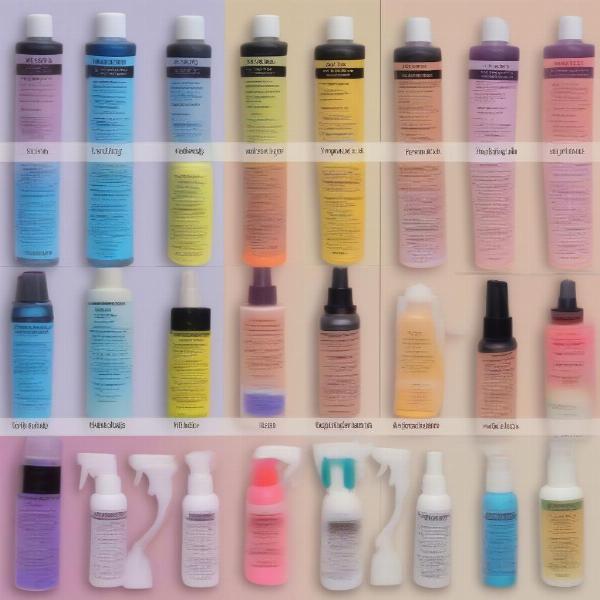Dog hair colouring has become increasingly popular, allowing owners to express their creativity and personalize their furry friends’ appearances. However, it’s crucial to prioritize your dog’s safety and well-being when considering dyeing their fur. This guide provides essential information on safe dog hair colouring practices, potential risks, and factors to consider before transforming your canine companion into a vibrant masterpiece.
Is Dog Hair Colouring Safe?
The safety of dog hair colouring depends entirely on the products used and the process followed. Never use human hair dye on dogs! Human hair dye contains harsh chemicals, such as peroxide and ammonia, that can be extremely toxic to dogs, causing skin irritation, allergic reactions, and even poisoning if ingested while grooming. Always opt for dyes specifically formulated for pets, which are typically made with natural ingredients and avoid harmful chemicals. Even with pet-safe dyes, a patch test on a small area of skin is recommended 24 hours before a full application to check for any adverse reactions.
Choosing the Right Dye for Your Dog
Selecting the appropriate dye is paramount for safe and effective dog hair colouring. Look for dyes that are explicitly labelled as non-toxic and pet-safe. Avoid dyes containing ammonia, peroxide, or other harsh chemicals. Natural dyes derived from plants are generally a safer option. Consider your dog’s breed, coat type, and overall health when choosing a colour and product. Consult with a professional groomer or veterinarian for personalized recommendations. permanent dog hair dye
Types of Dog Hair Dyes
Several types of dog hair dyes are available, including temporary, semi-permanent, and permanent options. Temporary dyes, such as chalks or sprays, wash out easily and are suitable for short-term colour changes. Semi-permanent dyes last a few washes, while permanent dyes require the coloured fur to grow out. Choose the type of dye that aligns with your desired duration and the frequency with which you’re comfortable reapplying.
 Different types of dog hair dyes
Different types of dog hair dyes
DIY Dog Hair Colouring vs. Professional Grooming
While some owners may be tempted to dye their dog’s hair at home, professional grooming is generally recommended, especially for intricate designs or if using permanent dyes. Groomers have the expertise and tools to apply the dye safely and effectively, minimizing the risk of skin irritation or uneven colouring. They can also advise on suitable colours and products based on your dog’s coat and skin type. If you decide to colour your dog’s hair at home, meticulously follow the instructions provided with the chosen product.
Potential Risks and Precautions
Even with pet-safe dyes, some risks are associated with dog hair colouring. Some dogs may experience allergic reactions to the dye, even if a patch test was conducted. Watch for signs of itching, redness, or swelling. If your dog ingests the dye while licking its fur, it could lead to digestive upset. Ensure the dye is completely dry before allowing your dog to groom itself. sable dog colour
Maintaining Coloured Dog Hair
To maintain the vibrancy and longevity of your dog’s coloured hair, use a shampoo and conditioner formulated for colour-treated fur. Avoid excessive bathing, as this can fade the colour. Protect your dog’s fur from prolonged sun exposure, which can also cause the colour to fade.
Conclusion
Dog hair colouring can be a fun and creative way to personalize your dog’s appearance, but it’s essential to prioritize their safety. By using pet-safe dyes, conducting patch tests, and following proper procedures, you can minimize potential risks and ensure a positive experience for both you and your furry friend. Remember, a happy and healthy dog is always more stylish than one with an unsafe dye job.
FAQ
- Is dog hair colouring permanent? It depends on the type of dye used. Temporary dyes wash out easily, while permanent dyes require the coloured fur to grow out.
- Can I use human hair dye on my dog? Absolutely not. Human hair dye is toxic to dogs and can cause severe health problems.
- What should I do if my dog has an allergic reaction to the dye? Immediately wash the affected area with water and contact your veterinarian.
- How long does the colour last? The duration varies depending on the dye type and the frequency of bathing.
- Can I colour my dog’s hair myself? While it’s possible, professional grooming is recommended, especially for intricate designs or permanent dyes. sable colour dog
- How do I choose the right dye for my dog? Look for pet-safe dyes and consider your dog’s breed, coat type, and health. Consult a groomer or vet for personalized advice.
- How can I maintain my dog’s coloured hair? Use colour-safe shampoo and conditioner, avoid excessive bathing, and protect their fur from the sun.
ILM Dog is a leading international online resource dedicated to providing expert advice on dog care and wellbeing. We cover a wide range of topics, from breed selection and health care to training, nutrition, and grooming. Our mission is to empower dog owners worldwide with the knowledge and resources they need to provide the best possible care for their canine companions. colouring a dog Whether you’re interested in learning more about dog breeds, nutrition, or dog grooming like colouring, ILM Dog is here to help. Contact us at [email protected] or +44 20-3965-8624 for expert guidance on all aspects of dog care.